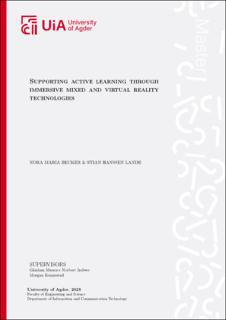| dc.description.abstract | As the world economies continue to grow, natural resources are being used at such high rates that
may negatively affect future generations. One of the issues is that the general population may know
some solutions for reducing energy consumption, for example in transportation, but few may know
about sustainable food production and sustainability concepts in a wider context. It can be challenging to create learning tools and learning content to suit the learning needs of the general population.
This master thesis explores mixed (MR) and virtual (VR) reality technologies as a support tool for
learning sustainability concepts through active learning strategies. The research investigates design choices and their effectiveness in creating immersive learning experiences as well as the user’s
perceived experiences of presence and motivation to learn. A human-centered design approach is
adopted to create a ‘sustainable future city’ use case focusing on learning concepts of sustainable
horticulture such as vertical farming, hydroponic-, aeroponic- and aquaponic systems.
The research investigates the state-of-the-art of MR and VR technologies, and looks into perceived
levels of presence and motivation in an immersive experience that combines MR and VR as one
application. Human-centered design activities taken include interviews with five randomly sampled
participants to validate requirements, interests in topics, and technology choices. Further on, design
and development tasks were carried out to develop a functional prototype running on Meta Quest
Pro head mount device. A mixed method approach was taken for the user testing and evaluation of
two design iterations. That involved user observation in UiA’s usability laboratory, questionnaire
and in-depth interviews with 10 participants. This study’s findings indicate that key design decisions for the immersive experience included guided exploration, realistic visualization, and hand
gesture interactions. Further, there were positive outcomes on both observation and feedback from
users as high levels of presence, fun, and interest in the topic were distinguished. Some main specific
findings were that while most participants were observed to experience presence as expected, one
participant indicated that they had a low sense of presence and were distracted by the environment
and unfamiliarity with the technology. This suggests that users can feel low levels of presence even
when they are fully involved in the virtual environment, because of the cognitive process required
to experience presence. Further regarding motivation, all participants stated they preferred the
immersive experience over traditional means such as textbooks, as it made learning more fun and
interesting in an active way.
The study was limited in scope and sample size, nevertheless it was concluded that overall the
design decisions made for the use case were at a large extent effective in supporting active learning,
and the designed tool can be easily used by the general population. | |
